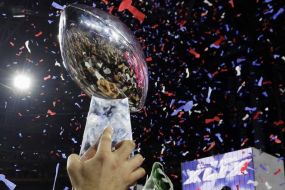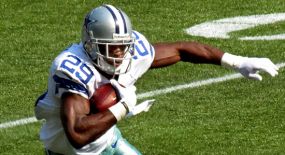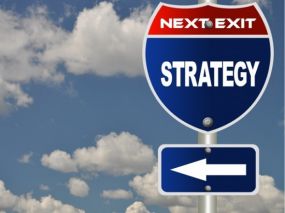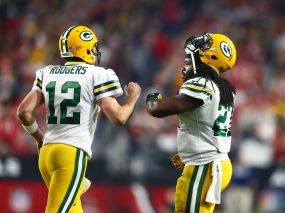Fantasy Football Podcast - 8/11/15 - 5 Draft Strategies to Consider
Every year, the fantasy football draft is one of the most important and fun moments of the season for fantasy team managers. Going into a draft there are many things that you need to keep in mind if you have any chance of winning the championship. What strategy, if any, will you employ during the draft? Will you be drinking copious amount of craft beers? Are you knowledgeable enough about the players in the league to be able to target and draft later round picks that will perform well over the course of the season? We're here to help, just tune in to help yourself!
(Listen to the Fantasy Football Podcast: 8/11/15, 5 Draft Strategies to Consider)
As we journey through the preseason, follow along with the drinkfive fantasy football podcast. In the next few weeks we'll be discussing in-depth the QBs, RBs, WRs, TEs and all other fantasy positions relevant to the 2015 season. Subscribe to our podcast on iTunes to get notifications whenever we release a new episode. We also broadcast the shows live at http://www.mixlr.com/drinkfive on Tuesday nights at 9pm CT. Feel free to browse over and join in the discussion!
Fantasy Football Podcast: 8/02/16, How to Draft a Winning Team in 2016
As we get closer to the 2016 NFL season, it's time to think about draft strategy for 2016. Each year strategies evolve and change and we're here to keep you on top of the latest and greatest - tune in to get a leg up on the competition and a head start to winning your league this year! We'll also be going over the biggest moves of the off-season and how they may impact the fantasy players involved. Stay tuned in all season for up-to-date injury and player news and more.
Listen to the Fantasy Football Podcast, 8/2/16: How to Draft a Winning Team in 2016
Subscribe to our podcast on iTunes to get notifications whenever we release a new episode. We also broadcast the shows live at http://www.mixlr.com/drinkfive on Tuesday nights at 8:30pm CT. Feel free to browse over and join in the discussion in the chat room!
5 Fantasy Football Draft Strategies to Consider for 2015
Over the years, many different kinds of draft strategies have come about for fantasy football leagues - I've tried to lay out the basics below for a few of the draft strategies that I see more frequently, and posed some questions that we try to answer on the podcast. Do you have any comments or insights to add? Feel free to leave them in the comments section!
(Listen to the Fantasy Football Podcast, 8/11/15: 5 Draft Strategies to Consider)
Best Available
It may seem perfectly obvious to some, but one very serviceable strategy during drafts is simply to take the best available player at any position that is available to you at that time. The main issue people run across when using this strategy is taking too many players at the same position. Say, for example, that the best player available on the draft board for 5 rounds in a row is a wide receiver. Should you simply continue to draft the best available player and hope to make trades later to make up any discrepancies at other positions? Should you compromise or bend your initial strategy to reach for another position that you have a bigger need at?
Zero RB The prevailing strategy for a long time in Fantasy Football was to load up on RBs early. This was for a few reasons: RBs tended to be used as the focal point of the offense for a lot of teams (at least up until recently), RBs seemed to be more consistent than their WR counterparts on a week-to-week basis (at least up until recently) and there was a more severe drop off of talent at the position (since most teams had one particular RB that they fed the football. More recently, a lot of teams are favoring throwing the ball more consistently and using a RB-by-committee approach.
The prevailing strategy for a long time in Fantasy Football was to load up on RBs early. This was for a few reasons: RBs tended to be used as the focal point of the offense for a lot of teams (at least up until recently), RBs seemed to be more consistent than their WR counterparts on a week-to-week basis (at least up until recently) and there was a more severe drop off of talent at the position (since most teams had one particular RB that they fed the football. More recently, a lot of teams are favoring throwing the ball more consistently and using a RB-by-committee approach.
What does that information tell us? RBs are still an extremely valuable position for a fantasy football team, but recent changes to the game and to how the position is being used in the NFL have forced a shift toward WR value being closer to the top, or in some cases eclipsing the value of their more grounded counterparts. There are exceptions, and most of those involve either running backs that are also heavily involved in the passing game (Jamaal Charles & LeVeon Bell) or guys that still hold roles similar to those of the old days of smash mouth football (Marshawn Lynch, Adrian Peterson).
Going with the Zero RB strategy asks you to forego the conventional fantasy wisdom that RBs are the most important assets to a team, and instead draft top-tier WRs, a TE and possibly a QB before dipping into the RB pool and selecting a variety of low to middle end situational guys with upside. Proponents of this draft strategy tell us that the top few tiers of RBs in the draft have the highest variance and therefore should be avoided. In other words, instead of high-risk picks at the beginning of the draft, you should be selecting guys that can offer a consistently good performance on the field while leaving some of that associated risk behind. Does this kind of strategy make sense even when you have the 1st or 2nd pick? Does the idea of Zero RB drafting get more enticing in a PPR league when WRs receive a rankings boost?
Value Based
Value Based Drafting (VBD) is a term that has been around since the 90’s. It refers to a particular strategy: by analyzing player’s past performances and calculating projections for them, and determining what the baseline player at each position is, you can determine the value of a player (which, using this strategy, is not simply how many points a player can score but rather how many more points he scores at his position than other players at the same position.
For example, although QBs score a large amount of points in most leagues, they are not usually among the most valued picks during the draft because in general they have low relative value compared to other positions at the same draft pick. That’s not to say that a player such as Aaron Rodgers or Andrew Luck will not score more fantasy points at the end of the year than other QBs, but the difference between their points and the QB baseline will be smaller than players like Marshawn Lynch relative to the RB baseline or Antonio Brown relative to the WR baseline. The problem is that these determinations rely on projected statistics, which are only estimations even if they are based on factual data.
Taking a look at the VBD data from 2014, for example, we can see that Rob Gronkowski was 40 points higher than the next best tight end in 2014 (Jimmy Graham). This tells us that if you can’t get Gronkowski in a draft, you should wait longer to select a tight end because their relative value decreases after Gronk. The same goes with Aaron Rodgers and Andrew Luck. If unable to land one of these two QBs last year, you were better off waiting until later rounds and instead taking players at RB and WR that would be the difference needed to win games.
Guided Tour
A strategy that I see all too often but will always encourage people to avoid. Far too many times, people walk into a draft with a set strategy in their head – not a strategy based on player value or lack thereof, but with a strict plan of what positions to target and in what order. I used to do this too, when I first started playing fantasy football. I would look at the previous year’s performance, or what positions seemed to have the best players available at the top rounds and create a roadmap in my head for the rest of the draft. RB, RB, WR, WR, TE, QB.. or WR, RB, RB, WR, RB, RB, WR, etc.
It makes sense in a very shallow sense. This also applies to people that draft a starting lineup and then begin to select players for their bench. Regardless of which strategy you choose to adopt, you should never, ever have a preconceived idea of which rounds that you want to draft specific positions in. The draft itself should dictate that. Besides that, you’re more likely to succumb to picking a positional player at the end of a run if you are thinking in this way. Don’t do it!
Late-Round QB
The Late-Round, or “Zero QB” strategy has become a popular one recently as well. There are so many quarterbacks in this league that produce at a consistent level, that the drop-off after the first few is not very large. In this case, doesn’t it make sense to wait until later rounds when you get take someone like a Ryan Tannehill, Eli Manning or Philip Rivers? Those guys all have top 10 potential but at a 9th or 10th round price in a standard league.
This is a bit of an offshoot of both VBD and Zero RB strategies, as the value in picking a quarterback not named Aaron Rodgers or Andrew Luck is not deemed high enough and it makes more sense to fill those slots with players that provide more of an advantage in a match-up. Just for example, say that you’re playing against someone that took a QB in the 4th round (Drew Brees, for example). Well, instead of Brees there you could have had someone like Brandin Cooks or DeAndre Hopkins. Signing on to this particular theory is as easy as saying that you would rather have DeAndre Hopkins and Ryan Tannehill than Drew Brees and Kevin White. I would. Would you?
Tips from 'Beer4TheBeerGod' – big contributor to the /r/fantasyfootball subreddit:
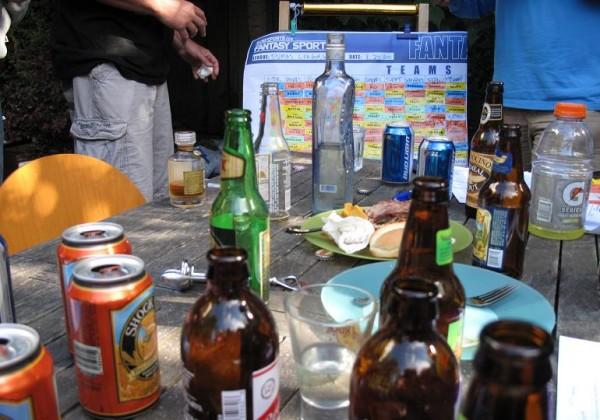 1. Know thy league. If your league uses PPR and your cheat sheet is for standard scoring you're putting yourself at a disadvantage. Know your roster requirements, number of teams, starting lineups, and all of your scoring rules. Things like 2QB, keepers, superflex (which is a nice way of saying 2QB with the option to fail), big play scoring, and six point passing touchdowns can dramatically alter how you draft. You should also know your opponents and their tendencies. Is one player a massive homer? Consider how that will affect his draft strategy. Does your league tend to draft QBs super early? Exploit that by picking up valuable skill positions and going with a streaming QB approach. This also applies to whatever sources your opponents use to draft, such as the default rankings.
1. Know thy league. If your league uses PPR and your cheat sheet is for standard scoring you're putting yourself at a disadvantage. Know your roster requirements, number of teams, starting lineups, and all of your scoring rules. Things like 2QB, keepers, superflex (which is a nice way of saying 2QB with the option to fail), big play scoring, and six point passing touchdowns can dramatically alter how you draft. You should also know your opponents and their tendencies. Is one player a massive homer? Consider how that will affect his draft strategy. Does your league tend to draft QBs super early? Exploit that by picking up valuable skill positions and going with a streaming QB approach. This also applies to whatever sources your opponents use to draft, such as the default rankings.
2. The level of risk you are willing to take should correlate with the round of the draft. Your early picks are not for flyers, they're for reliable sources of points that can form the core of your team. I've come to be very risk averse in my early picks, mostly because of the damage done by drafting guys like Darren McFadden or Toby Gerhart. Look at the history of your player and any disruptive factors (age, usage, coaching change, team change) that could increase the uncertainty of the prediction. I'm also not a fan of taking rookies in early rounds for this reason.
3. Know the opportunity cost of your draft choices. Opportunity cost is the essentially the price you pay for the road not travelled. In fantasy terms it's the value of the players you won't draft because of your choice, either because your positional need is decreased or because someone else will draft them. This is one of the core philosophies behind value based drafting, but it's more than just points. It requires you to not only know how you will draft, but ideally also your opponents. Will you drafting player X force your opponent to draft player Y, or will that guy still be around on your next turn? The greatest feeling in the world is when you make your pick and someone after you cries out in anguish.
4. Develop your own tools for draft day and practice with them. I started making BeerSheets because I wanted something I could print out, bring with me wherever I went, and know that I could follow it to create my team. It needed to be fast, easy to read, and provide enough information to make the right decision without overwhelming you with data. Some drafts let you bring computers, others are just yourself and your mind. Whatever the rules, make sure you have the tools available so that you can stay on top of the draft order and always get the most value.
5. Tiers are superior to rankings. There is no way to predict that player X will do better than player Y with enough fidelity to rank them before the season starts. This is why I'm such a fan of using tiers to determine the relative projections of players. Realistically if two players are ranked right next to each other then there probably isn't enough of a difference to matter and you should be considering other qualities such as historic performance, opportunity, injury risk, competition, and upside.
6. Don't be a homer, but it's okay to have multiple guys on the same team. Aside from bye weeks it's not that big of a deal. What you don't want to do is be predictable enough for someone else to exploit your tendencies. The other side of this is drafting players from your team's rival. Can you stomach having someone you hate on your team? If the value is there consider swallowing your pride. Moral victories are for losers.
7. Don't be afraid to reach. The best experts in Fantasy Football average a 60% accuracy. Remember that the numbers are just guesses, and if you have a gut feeling there's nothing wrong with going with it. In the end it's your team and you should be happy with it.
8. The less predictable a position, the later that position should be drafted. This means drafting kickers and DSTs very late unless your scoring rules are weird enough to require a special strategy. Unless your draft rules require that you fill out your roster then don't bother getting a kicker. Use that last pick on a total flyer and see if anything changes leading up to Week 1. Just don't forget to pick up a kicker off the WW before your first game.
9. The maximum value you will get for your trade bait is the draft pick you just wasted, so don't even bother. Some people exercise a strategy of picking someone up with the express purpose of trading them immediately. Remember, the four QBs you cleverly picked up even though you didn't need them were passed over by everyone else. You just sacrificed a team need for a lottery ticket that isn't likely to pay off. This is a particularly egregious mistake in the top half of the draft. This is different from drafting a late round flyer and hoping they turn out to be a sleeper, which is sound draft strategy.
10. You can lose your league in the draft, but you win it in the waiver wire. No matter how well or poorly you draft, that's only a part of the game. Once the draft is done the real game begins. Follow the waiver wire religiously, and don't be afraid to drop your late round scrubs for something more promising if you get more information. I'm less enthusiastic about preseason trades unless you have access to new information or you're fleecing a homer.
11. Mock until you can draft in your sleep. Mock drafting is a fantastic resource. Not only is it fairly fun, but it also helps you see how players will be taken and understand trends. If you can get to the point where you can instantly see a reach or a steal then when the real draft happens you'll be far more prepared.
How to Draft a Winning Team in 2016
Each new fantasy football season brings along its own sets of dos and don’ts during the draft that depend on a ton of different variables: among them changing schemes in the NFL, teams forming committees at a specific position and your league’s specific rules and draft inclinations. This show is all about how to identify those things and use them to your advantage to draft the best possible team this season.
Listen to the Fantasy Football Podcast, 8/2/16: How to Draft a Winning Team in 2016
Important off-season moves and updates in 2016:
Fitzpatrick finally re-signed with the Jets – One year, 12 million dollar contract.. ups the values of all offensive players on the Jets. Thoughts on the Jets chances this year? As good or better than in 2015.
Arian Foster signs with the Dolphins – And he looks like he’s in great shape and will easily take over the #1 role in Miami. The issue is that by mid-season the Dolphins may not have a healthy RB between Foster and Ajayi!
Rams relocating to Los Angeles from St. Louis – This news seemed like an eventuality.. how will the team moving affect their performance this season? As they’re a rebuilding team, will it even matter at all? Probably not.
Josh Gordon is back in the game – He’ll miss the first four games but will be back in uniform.. after last year it may be tough to trust this guy but he is the only receiver in the NFL to ever record back-to-back 200 yard games, he’s only 25-years-old and he’s clearly making an effort to turn things around.
Philadelphia Eagles sketchy QB situation – Not only are they keeping Sam Bradford and Chase Daniel (and paying them a decent amount to boot), but they traded up to No. 2 in order to draft Carson Wentz as their up-and-coming guy. Not to mention the fact that new head coach Doug Pederson will likely tone down the formerly pass-happy offense.
Steelers are shooting themselves in the foot – With all of the suspensions and injuries so far this year (Le’Veon Bell - 4 games, Martavis Bryant - 2016 season, Senquez Golson – Lisfranc injury, 12 weeks) the Steelers need to straighten up and fly right. The season hasn’t started yet, guys!
Eddie Lacy – A P90X workout all off-season with founder Tony Horton has helped Lacy get back into shape and he could once again be a top 5 RB option for the 2016 season.
Peyton Manning finally retires – and backup Brock Osweiler walks to Houston where he’ll be the starter. I think I could throw a few passes to Deandre Hopkins, but in all seriousness this is actually a decent landing spot for the new QB. Lamar Miller looks to finally have a bellcow role there as well. Can the Texans be a playoff team in 2016?
Tom Brady – Looks like Brady will finally be getting those 4 games that he was able to avoid in 2015. Jimmy Garoppolo will stand in for him during those first few games.
Draft Strategies for 2016:
Best Overall – Regardless of the many draft strategies out there, this is always a good option. Simply put, it means either creating or grabbing a set of overall rankings that you trust and believe in and then taking the best player available at all times (with the possible exception of later when you have too many of a particular position, etc). Even if you end up taking more RBs or WRs than you wanted early, for example, you could trade them off for the types of players that you might be looking for later.
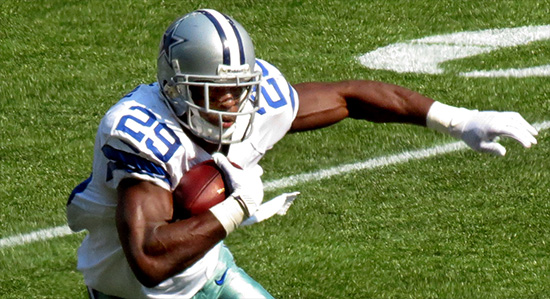
Zero RB – A lot of writers out there have done pieces on the Zero RB strategy for fantasy football, but it was pioneered by Shawn Siegele at RotoViz several years ago. The idea is basically that going RB heavy has long been a fixture of fantasy football drafts since there are not usually many ‘bellcow’ RBs available. This draft strategy is setting up your team to steadily improve as the season goes on and gambling against the injury risks that seem to occur more often with RBs than with WRs due to their exposure and frequency to big hits. A team that drafts RB heavy in the first few rounds may start off strong but not be able to get over the mid-season or playoff hump as the injury issues begin to take their toll. This is not to say that WRs are immune to injury themselves, of course!
If we look at statistics from past years, it’s common that the top RBs at the end of the season are not even close to the top RBs that were drafted – according to research by 4for4.com, for example, less than half of RBs drafted in the top 10 in the last 5 years ended up providing top 10 value.
Contingency-Based Drafting – Another way to draft which can piggyback on the Zero RB strategy is to draft against injuries. Author and former day trader Nassim Taleb came up with a term for this – something that benefits from chaos – called antifragility. This would refer to a team that is built so that if a random injury, etc was to happen the team may actually get better, or at least doesn’t struggle. If RBs touch the ball more than WRs than we wouldn’t want to draft them using high picks because they would be more likely to succumb to the randomness of injuries. RBs are also more replaceable by their counterparts.. with some exceptions, an average running back can become a fantasy stud if you put him behind a great offensive line. If your 1st round pick tears an ACL, that is far more damaging than an 8th, or 9th, or 10th round pick.
This strategy, therefore, champions drafting multiple RBs in a committee, or grabbing RBs from the waiver wire during the season. The other teams that are drafting RBs early are the same ones that pick up handcuffs that may not be worth anything, and have weak WRs because of their early dependency on RBs.
Grab pass-catching RBs – Whether in PPR or not, grabbing RBs that also have a role in the passing game like Charles Sims, etc is a good bet for teams that want to wait for most of the draft before picking up players in the RB position. Also guys that may be in a committee but are behind a strong offensive line.
Recent Articles
-
NFL Confidence Pool Picks & Strategy 2024 - Week 18
 To say this has been a year of uncertainty is an understatement. So many injuries, coaching changes, player issues shaped…in Fantasy Football / NFL
To say this has been a year of uncertainty is an understatement. So many injuries, coaching changes, player issues shaped…in Fantasy Football / NFL -
NFL Confidence Pool Picks & Strategy 2024 - Week 17
 Christmas is indeed the time of giving. And this year, the NFL is giving us a double-header on Christmas Day…in Fantasy Football / NFL
Christmas is indeed the time of giving. And this year, the NFL is giving us a double-header on Christmas Day…in Fantasy Football / NFL -
NFL Confidence Pool Picks & Strategy 2024 - Week 16
 Normally, being just a few weeks away from the end of the season, playoff positions are solidified and we need…in Fantasy Football / NFL
Normally, being just a few weeks away from the end of the season, playoff positions are solidified and we need…in Fantasy Football / NFL -
NFL Confidence Pool Picks & Strategy 2024 - Week 15
 Finally! They’re done! We are heading into week 15 and FINALLY we are done with bye weeks! 16 games a…in Fantasy Football / NFL
Finally! They’re done! We are heading into week 15 and FINALLY we are done with bye weeks! 16 games a…in Fantasy Football / NFL
 Please wait...
Please wait...- Home
- Fantasy Football / NFL
- zero rb
